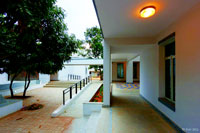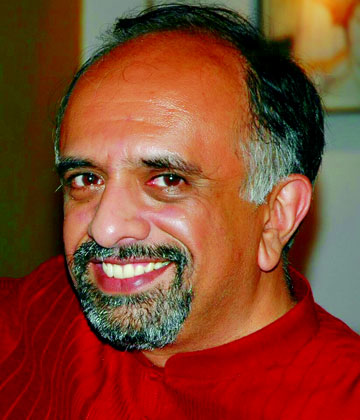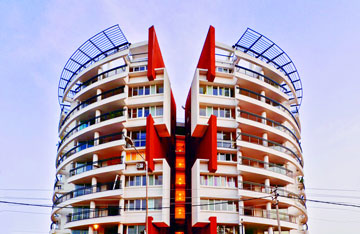Nature- The Essential Core of Architecture
CnT Architects is Bangalore’s first architectural firm, founded in 1947 that is acclaimed for introducing modern architecture to the city. One of its earlier landmark projects, HMT in Hyderabad received extols from everywhere. The work was even published in the magazine of Royal Institute of British Architecture in 1965. “Ever since its inception, the firm has been engendering award winning projects for many of the top corporate institutional real estate players in India and international companies in India,” informs, Ar. Prem. While recounting the inheritance of the firm, he says the first practice began in 1950 by the founder of the firm and Ar. Prem’s father, Mr. Narayan Chandavarkar, after his demise in 1963, the firm was continued by his wife, Ms. Tara Chandavarkar, along with Mr. Pesi Thacker who joined as the architect partner. Later, the firm rechristened as CnT (Chandavarkar & Thacker) Architects.
 |
CnT is involved in designing some of the coveted projects including the first Infosys campus in Bangalore and first tallest residential tower in Bangalore, Exotica by Brigade Group. Corporate headquarters of Dr. Reddy Laboratories in Hyderabad and the Indian Institute of Management, Trichy are on the cards. |
For Ar. Prem, heading the inherited firm was not icing on the cake in the initial days. “When I took over, the firm already had a sustained reputation of commitment to a work culture of courtesy, collaboration, professionalism and a high ethical standard. Even though my family was running architectural practice, I groomed myself in different surroundings. So, I worked for Kanvinde Rai & Chowdhury in Delhi for three years, moved to the US to pursue masters, where I also worked for three years. We emphasise on architectural practice in collaborative manner with clients and not being egotistical. We believe in upholding the best practice standards in the profession. Our ethical practice remained constant and hence even though different people have come to manage the firm, the value system has remained the same,” he adds.
Ar. Prem received his training at the School of Planning and Architecture, New Delhi, India (B.Arch. 1978) and at the University of Oregon, USA (M.Arch. 1982). He is a former Executive Director of Srishti School of Art Design & Technology in Bangalore. He is an academic advisor and guest faculty at some of the top architecture colleges in India.
He was always inclined towards pursuing engineering in technical areas. Eventually, as he decided to combine both creative and technical and therefore architecture was the natural choice. “When I started involving in our own firm, the first key office building I designed was Infosys, India’s first software campus, completed in 1994.”
Crux of Architecture
Ar. Prem swears by CnT’s motto-‘Enrich Life through Architecture’. After all, a good architecture is creating spaces that are enjoyable and inspirational for the inhabitants. Any architectural design should go beyond problem solving and functionalism, yet inspirational! He hints on few key points for a successful architecture. “An architect must intercommunicate well with clients in holistic manner learning about their lifestyles, interests and kind of houses they lived in. Listen and learn from customers yet, at the same time, be aware of what your own discipline and potential. Eventually, your goal is to serve both your customer and the cause of architecture. The resultant of such a meticulous process will be a unique structure,” he adds.
Such intercommunication must translate at different levels depending on the client an architect works with. He goes on, “For a real estate developer, we get acquainted about the brand and how they differentiate themselves from others. While designing an office set-up, we try to understand the nature of business, culture of the workforce from which we evolve a design.”
‘Contemporary Architecture’ in common parlance is being associated with those buildings mimicking the west. On the other hand, contemporary building is that which successfully addresses inhabitation aspects. “I advise young architects not to get influenced by what is said and what is seen either in America or Europe and we need not emulate those designs. The crux of the architecture lies in true understanding of the socio-cultural aspect of the region, indoor climate quality and factors influencing the immediate surroundings” he observes. In a temperate climate like India, the angle of the sun is closer to the vertical. The shadow caused on the horizontal plane takes the precedence and hence we can infuse greater transparency in our spaces. In fact, the variation of shadow on ground is one of the important aspects of any architectural design in traditional Indian architecture. If we design our structures with these principles in mind, we can effectively come up with very contemporary and uniquely Indian suitable to Indian climate.
Core of architecture lies in understanding basics of nature and culture of inhabitation, he elucidates. With proper flow of light and air, building emits energy. As in yoga, the concept of prana is the breath and without it the body is dead. Similarly, in architecture, the prana represents people who dwell in the building. The breeze that moves through and the sunlight that strikes it, keep the building alive. All these elements are necessary. A building that is not lived in, deteriorates faster than the building that is lived in. so, the energy flow is very important.
Unfortunately, sustainability is a buzzword now and according him, it is not a special entity rather it is a responsibility of each and every individual to be honest with the nature and it is the basic way of life. He makes it a point to mention the importance of sustainability to younger architects.
Time and Space to Learn
To develop an expertise over design, Ar. Prem recommends architects to spend ample time to gain mastery over it. “Connect with people who teach you and seek to connect with what you intuitively feel is authentic and don’t get captured by fashions and trends. Be your own person and hook up to what is of value in terms of creating great space and a great experience of inhabitation. As architects we can make a big difference to lives of people. If we create the right kind of space, inhabitants, we can aid them in achieving their potential,” he adds.
 |
Emergence of technology has swooped and transformed the way a building functions, in terms of materials and in the design process as well. “The way technology has aided in design process has gone a sea change. We use Revit software, a parametric 3D modelling software and the entire experience of designing is different. However, technology should be implemented but it is not a fundamental thing. In architecture, the fundamental thing is the quality of the space you create, the quality of the experience you create. Use technology for a purpose,” he informs.
Design of Urban Cities
He shares his views on urbanisation. Architects have a role to play in urbanization as well. The urban governance is not authentic and architects have to lobby and work together to make a difference. They have to work together with relevant stake holders for an effective working of cities. For a long time, urbanization was mere 20%, and now we have crossed 30% and the rate is going to increase. It is the need of the hour. Cities work in a way that’s very different from the way individual buildings work. To integrate individual building keeping cityscape in mind is a challenge given in the present building codes scenario. You can’t extend that thinking of an individual building to the level of a city.
“I think urban design will be a much needed field in India for the time to come. There is an urgent need for an appropriate regional planning to enable an effective hierarchy of settlements. Currently, the working model skews towards the metropolitan cities and they are bursting at the seams. Tier-I and Tier-II towns have been neglected. Therefore, we need a hierarchy that looks at all of them. City sustains a way of life and it tends to enhance creativity as it brings lot of people together. We need to design spaces in city that facilitate people to come together such as the squares, parks, streets and so on that is a subject of design in the present scenario. Local governance has to be strengthened to make it more democratic and transparent,” he affirms.
|

|
| To integrate individual building keeping cityscape in mind is a challenge given in the present building codes scenario. |
As a summing up point during the interview, Ar. Prem speaks about his passion for continuous learning despite having few decades of professional experience. He loves to learn about cities and art. “Art plays a very important role in the development of culture. Since our life is continuously changing, we don’t know to measure who we are. Art is way to understand yourself and where you stand and it can become a reference point. In India, if you look at tribal cultures, rural cultures, even a mud wall or a clay pot or a coconut scarper will be made into pieces of art and that’s how they understand their world. Similarly, that is how you can use art to understand yourself. It is not what value it has or how pretty it looks,” he adds.
Ar. Prem strongly believes in contributing to society and he takes on projects for a worthwhile cause without charging fees. Recently CnT Architects has done a project for the missionaries of charity where they have created a home for mentally challenged and destitute women.